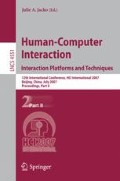Abstract
Several factors make it difficult to quantify the usability of mobile phones. Nevertheless, a quantified value of the usability could be used for several purposes, such as design innovation and benchmarking. This paper proposes three approaches (task centred, usability indicator-based, and design area-based quantification) to quantifying the usability of mobile phones on the basis of a hierarchical model of usability factors. Each of them provides process and rules for calculating the usability score of a mobile phone by applying weighting value assignment methods. Through two case studies, we could obtain empirical data to be used for determining the weighting value for quantification and confirm the usefulness of the proposed approaches.
Access this chapter
Tax calculation will be finalised at checkout
Purchases are for personal use only
Preview
Unable to display preview. Download preview PDF.
References
Ham, D-H., Heo, J., Fossick, P., Wong, W., Park, S., Song, C., Bradley, M.: Conceptual Framework and Models for Identifying and Organizing Usability Impact Factors of Mobile Phones. In: Proceedings of 2006 Annual Conference of the Australian Computer-Human Interaction Special Interest Group (OZCHI 2006), Sydney, Australia (November 2006)
Hornbæk, K.: Current Practice in Measuring Usability: Challenges to Usability Study and Research. Int. J. Human-Computer Studies 64(2), 79–102 (2006)
Keinonen, T.: One-Dimensional Usability-Influence of Usability on Consumers’ Product Preference. Unpublished Doctoral Dissertation, University of Art and Design and Helsinki (1998)
Ketola, P., Röykkee, M.: The Three Aspects of Usability in Mobile Handsets. Paper Presented at the Workshop of ACM Conference on Human Factors in Computing Systems (ACM CHI 2001), Seattle, USA (March-April 2001)
Lohse, G.L., Spiller, P.: Quantifying the Effect of User Interface Design Features on Cyberstore Traffic and Sales. In: Proceedings of ACM Conference on Human Factors in Computing Systems (ACM CHI 1998), Los Angeles, USA (April 1998)
Rauterberg, M.: An Empirical Validation of Four Different Measures to Quantify User Interface Characteristics Based on a General Descriptive Concept for Interaction Points. In: Proceedings of IEEE Symposium and Workshop on Engineering of Computer-Based Systems, Friedrichshafen, Germany (March 1996)
Rauterberg, M.: How to Measure and to Quantify Usability of User Interfaces. In: Özok, A., Salvendy, G. (eds.) Advances in Applied Ergonomics, West Lafayette, USA Publishing, pp. 429–432 (1996)
Rubinoff, R.: How to Quantify the User Experience (2006), Available online via http://www.sitepoint.com/article/quantify-user-experience
Saaty, T.L.: How to Make a Decision. The Analytic Hierarchy Process. Interfaces 24(6), 19–43 (1994)
Sauro, J., Kindlund, E.: A Method to Standardize Usability Metrics into a Single Score. In: Proceedings of ACM Conference on Human Factors in Computing Systems (ACM CHI 2005), Portland, USA (April 2005)
SUMI (2006), available online via http://sumi.ucc.ie
Yang, C-C.: The Refined Kano’s Model and Its Application. Total Quality Management 16(10), 1127–1137 (2005)
Author information
Authors and Affiliations
Editor information
Rights and permissions
Copyright information
© 2007 Springer-Verlag Berlin Heidelberg
About this paper
Cite this paper
Ham, DH. et al. (2007). Model-Based Approaches to Quantifying the Usability of Mobile Phones. In: Jacko, J.A. (eds) Human-Computer Interaction. Interaction Platforms and Techniques. HCI 2007. Lecture Notes in Computer Science, vol 4551. Springer, Berlin, Heidelberg. https://doi.org/10.1007/978-3-540-73107-8_32
Download citation
DOI: https://doi.org/10.1007/978-3-540-73107-8_32
Publisher Name: Springer, Berlin, Heidelberg
Print ISBN: 978-3-540-73106-1
Online ISBN: 978-3-540-73107-8
eBook Packages: Computer ScienceComputer Science (R0)

